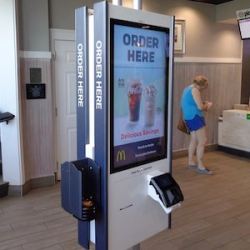A story that has gone viral (again) claims that McDonald's touchscreen menus are covered in poop. Is it true?
No. There is no brown, smelly fecal matter covering McDonald's touchscreens. The global headlines saying otherwise are total lies. So, on what basis are they making that ridiculous claim?
In November 2018, a British tabloid called Metro published a "study" (I'm using that term loosely) by a microbiologist in London who sampled McDonald's touchscreens to determine what sort of microbes were present. To the surprise of nobody except click-hungry media outlets, the microbiologist found lots of bacteria, some nastier than others.
Before delving into the details of what he found, let's first address three major issues with this "study."
Numerous Problems with the McDonald's Poo Study
First, it's not a study. It wasn't published in a peer-reviewed journal. It is literally nothing more than a guy walking around swabbing McDonald's touchscreens for a newspaper article. There isn't even a methods section for anyone to analyze.
Second, there is no comparison group. A proper study would compare the bacteria found on McDonald's touchscreens to those found on other things, like door handles or touchscreens at other restaurants. (What do you bet that the touchscreens used to purchase London subway tickets are also gross?) This study did not do that, which makes it look as if the sole motivation was to make McDonald's look bad.
Third, just because potentially scary bacteria can be found somewhere does not mean they pose a real threat to our health. Because we have a digestive system (complete with acid and enzymes) and an immune system, it is nearly impossible for one or two bacteria to cause disease. Instead, a person usually needs to ingest hundreds, thousands, or even millions of bacteria to become sick (with a foodborne illness, anyway). Unfortunately, the researcher didn't bother to report how much bacteria he found.
Bearing all that in mind, let's examine the findings.
Nothing to See Here
The microbiologist detected bacteria found in human feces (collectively known as coliforms) on McDonald's touchscreens. If that upsets you, then you should throw away your smartphone, because there's a chance that it too is covered in coliforms. And guess what? Your toothbrush might be covered in them as well.
The article also reported the presence of Staphylococcus. This is a potentially concerning bug, especially if it's antibiotic resistant (like MRSA), but keep in mind that the bacterium is normally carried by about 33% of healthy people, often in their noses. Thus, Staphylococcus is going to be found just about anywhere humans are found.
Similarly, Listeria is a scary microbe, given its association with lethal foodborne outbreaks. But it's also ubiquitous in the environment, even surviving in the soil. The number of Listeria bacteria a person needs to consume to become infected (known as the infectious dose) is not precisely known, but it's thought that most people can eat a few without getting sick.
Once again, the media has run wild with a "nothing-to-see-here" type of story. If you're a healthy, immunocompetent person, then there's nothing to worry about. Just wash your hands before you eat.

